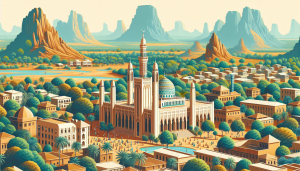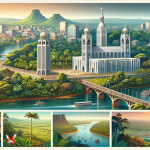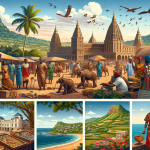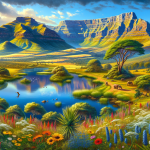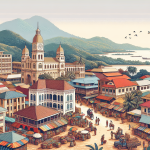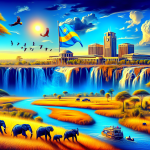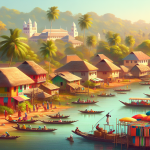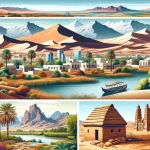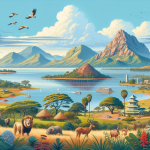Burkina Faso: The Hidden Gem of West Africa
Burkina Faso, often overshadowed by its more popular West African neighbors, is a land of immense cultural richness, stunning landscapes, and a warm, welcoming population. Nestled in the heart of West Africa, this landlocked country offers a unique tapestry of experiences that range from bustling markets and vibrant festivals to serene national parks and ancient archaeological sites. Despite facing numerous challenges, including economic constraints and political instability, Burkina Faso stands resilient with a spirit that is both inspiring and contagious. Whether you’re a seasoned traveler looking for an off-the-beaten-path adventure or a culture enthusiast eager to delve into the traditions of the Mossi, Fulani, and other ethnic groups, Burkina Faso promises an unforgettable journey. In this guide, we will explore the key attractions, cultural highlights, and practical tips for making the most of your visit to this underrated gem.
The Vibrant Capital: Ouagadougou
A Cultural Melting Pot
Ouagadougou, affectionately known as “Ouaga,” is not just the political capital of Burkina Faso but also its cultural heartbeat. The city is a melting pot of various ethnic groups, offering a rich tapestry of traditions, languages, and culinary delights. The International Art and Craft Fair of Ouagadougou (SIAO) is a must-visit event, showcasing the finest in African craftsmanship. Held biennially, this event attracts artisans from across the continent, making it a hub for anyone interested in African art.
Must-Visit Places in Ouagadougou
- National Museum of Burkina Faso: This museum offers a deep dive into the country’s history, culture, and traditions. From ancient artifacts to contemporary art, it provides a comprehensive overview.
- Ouagadougou Cathedral: One of the largest cathedrals in West Africa, it stands as a testament to the country’s colonial past and its enduring faith.
- Laongo Sculpture Symposium: Located a short drive from the city, this outdoor gallery features stunning rock sculptures crafted by artists from around the world.
Natural Wonders: Parks and Reserves
Arli National Park
Arli National Park, located in southeastern Burkina Faso, is a sanctuary for wildlife enthusiasts. Covering an area of approximately 760 square kilometers, the park is home to a diverse range of species, including elephants, lions, and hippos. The park’s varied landscapes, from savannas to woodlands, offer a perfect backdrop for wildlife photography and bird watching.
W National Park
Part of a transboundary reserve shared with Niger and Benin, W National Park is another gem for nature lovers. The park gets its name from the W-shaped bend in the Niger River and is a UNESCO World Heritage site. Visitors can expect to see a wide range of wildlife, including buffaloes, antelopes, and various bird species. Guided tours are available, offering a safe and informative way to explore the park.
Cultural Festivals and Traditions
FESPACO: The Panafrican Film and Television Festival
One of the largest film festivals in Africa, FESPACO (Festival Panafricain du Cinéma et de la Télévision de Ouagadougou) is held biennially in Ouagadougou. The festival showcases a myriad of films from across the continent, providing a platform for African filmmakers to shine. It’s a fantastic opportunity for visitors to engage with African cinema and its diverse storytelling traditions.
The Festival of Masks
Held in the town of Dédougou, the Festival of Masks is a vibrant celebration of Burkina Faso’s rich cultural heritage. The festival features traditional dances, music, and mask performances from various ethnic groups. It’s a colorful and lively event that provides deep insights into the country’s cultural fabric.
Exploring Ancient Sites
Loropéni Ruins
A UNESCO World Heritage site, the Loropéni Ruins are one of Burkina Faso’s most intriguing archaeological sites. These ancient stone ruins date back to between the 11th and 19th centuries and are believed to be linked to the trans-Saharan gold trade. The site offers a fascinating glimpse into the region’s history and its connections to broader African and global trade networks.
Sindou Peaks
The Sindou Peaks, located near the town of Banfora, are a geological wonder. These striking rock formations, sculpted by erosion over millions of years, create a surreal landscape that is perfect for hiking and photography. The area is also steeped in local folklore, adding an extra layer of intrigue to your visit.
Practical Travel Tips
Health and Safety
When traveling to Burkina Faso, it’s essential to take certain health precautions. Ensure you’re up-to-date on vaccinations, including yellow fever, which is required for entry. Malaria is prevalent, so taking antimalarial medication and using mosquito repellent is advisable. Always drink bottled or purified water to avoid waterborne illnesses.
Getting Around
Public transportation in Burkina Faso includes buses, minibusses, and taxis. While buses are a reliable way to travel between cities, taxis and motorbike taxis (known as “zemidjans”) are convenient for getting around within cities. Renting a car with a driver is another option for more comfortable and flexible travel.
Currency and Language
The official currency is the West African CFA franc (XOF). ATMs are available in major cities, but it’s advisable to carry some cash, especially when traveling to remote areas. French is the official language, but many local languages, including Mooré and Dioula, are widely spoken. Learning a few basic phrases in French can go a long way in enhancing your travel experience.
Culinary Delights
Burkina Faso offers a variety of unique culinary experiences. The cuisine is hearty and flavorful, often featuring staples like millet, sorghum, and maize. Popular dishes include:
- Riz Gras: A savory rice dish cooked with vegetables and meat, often seasoned with local spices.
- To: A traditional dish made from millet or maize flour, usually served with a sauce.
- Poulet Bicyclette: Free-range chicken, often grilled or fried, and a favorite among locals and visitors alike.
Street food is also a significant part of the culinary landscape. Bissap, a refreshing drink made from hibiscus flowers, and Dolo, a traditional millet beer, are must-tries.
Sustainable Travel in Burkina Faso
As tourism grows in Burkina Faso, sustainable travel practices become increasingly important. Here are some tips to ensure your visit has a positive impact:
- Support Local Businesses: Buy from local artisans, eat at locally-owned restaurants, and stay in locally-operated accommodations.
- Respect Local Customs: Take the time to learn about and respect local customs and traditions. This fosters mutual respect and enriches your travel experience.
- Minimize Waste: Use reusable water bottles, bags, and containers to reduce plastic waste. Dispose of waste responsibly and recycle whenever possible.
- Conserve Resources: Be mindful of your water and energy usage, especially in areas where these resources are scarce.
Conclusion: Embrace the Adventure
Burkina Faso may not be the first destination that comes to mind when planning a trip to Africa, but it offers an array of unique experiences that are hard to find elsewhere. From its vibrant cultural scene and historical sites to its stunning natural landscapes, the country is a treasure trove waiting to be explored. The warmth and hospitality of its people only add to the charm, making every visitor feel like they’ve found a home away from home. So pack your bags, open your heart to new experiences, and embark on an adventure that promises to be as enriching as it is exciting.
For more information on traveling to Burkina Faso, visit the Burkina Faso Tourism Board.
